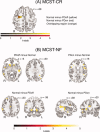Levodopa and the feedback process on set-shifting in Parkinson's disease
- PMID: 21438075
- PMCID: PMC6869935
- DOI: 10.1002/hbm.21187
Levodopa and the feedback process on set-shifting in Parkinson's disease
Abstract
Objective: To study the interaction between levodopa and the feedback process on set-shifting in Parkinson's disease (PD).
Methods: Functional magnetic resonance imaging (fMRI) studies were performed on 13 PD subjects and 17 age-matched healthy controls while they performed a modified card-sorting task. Experimental time periods were defined based on the types of feedback provided. PD subjects underwent the fMRI experiment twice, once during "off" medication (PDoff) and again after levodopa replacement (PDon).
Results: Compared with normal subjects, the cognitive processing times were prolonged in PDoff but not in PDon subjects during learning through positive outcomes. The ability to set-shift through negative outcomes was not affected in PD subjects, even when "off" medication. Intergroup comparisons showed the lateral prefrontal cortex was deactivated in PDoff subjects during positive feedback learning, especially following internal feedback cues. The cortical activations were increased in the posterior brain regions in PDoff subjects following external feedback learning, especially when negative feedback cues were provided. Levodopa replacement did not completely restore the activation patterns in PD subjects to normal although activations in the corticostriatal loops were restored.
Conclusion: PD subjects showed differential ability to set-shift, depending on the dopamine status as well as the types of feedback cues provided. PD subjects had difficulty performing set-shift tasks through positive outcomes when "off" medication, and showed improvement after levodopa replacement. The ability to set-shift through negative feedback was not affected in PD subjects even when "off" medication, possibly due to compensatory changes outside the nigrostriatal dopaminergic pathway.
Copyright © 2011 Wiley Periodicals, Inc.
Figures




Similar articles
-
Levodopa influences striatal activity but does not affect cortical hyper-activity in Parkinson's disease.Eur J Neurosci. 2012 Feb;35(4):572-83. doi: 10.1111/j.1460-9568.2011.07979.x. Epub 2012 Feb 3. Eur J Neurosci. 2012. PMID: 22304628
-
Levodopa-sensitive, dynamic changes in effective connectivity during simultaneous movements in Parkinson's disease.Neuroscience. 2009 Jan 23;158(2):693-704. doi: 10.1016/j.neuroscience.2008.06.053. Epub 2008 Jul 3. Neuroscience. 2009. PMID: 18722512 Clinical Trial.
-
Levodopa medication improves incidental sequence learning in Parkinson's disease.Neuropsychologia. 2016 Dec;93(Pt A):53-60. doi: 10.1016/j.neuropsychologia.2016.09.019. Epub 2016 Sep 26. Neuropsychologia. 2016. PMID: 27686948 Free PMC article.
-
Gender differences in Parkinson's disease.Gend Med. 2007 Mar;4(1):8-18. doi: 10.1016/s1550-8579(07)80003-9. Gend Med. 2007. PMID: 17584622 Review.
-
Effects of Oral Levodopa on Balance in People with Idiopathic Parkinson's Disease.J Parkinsons Dis. 2023;13(1):3-23. doi: 10.3233/JPD-223536. J Parkinsons Dis. 2023. PMID: 36617752 Free PMC article.
Cited by
-
Parkinson's disease dementia: a neural networks perspective.Brain. 2015 Jun;138(Pt 6):1454-76. doi: 10.1093/brain/awv104. Epub 2015 Apr 16. Brain. 2015. PMID: 25888551 Free PMC article. Review.
-
Cognition Deficits in Parkinson's Disease: Mechanisms and Treatment.Parkinsons Dis. 2020 Mar 24;2020:2076942. doi: 10.1155/2020/2076942. eCollection 2020. Parkinsons Dis. 2020. PMID: 32269747 Free PMC article. Review.
-
Dopamine in the prefrontal cortex plays multiple roles in the executive function of patients with Parkinson's disease.Neural Regen Res. 2024 Aug 1;19(8):1759-1767. doi: 10.4103/1673-5374.389631. Epub 2023 Dec 11. Neural Regen Res. 2024. PMID: 38103242 Free PMC article.
-
A dynamic computational model of the parallel circuit on the basal ganglia-cortex associated with Parkinson's disease dementia.Biol Cybern. 2024 Apr;118(1-2):127-143. doi: 10.1007/s00422-024-00988-x. Epub 2024 Apr 21. Biol Cybern. 2024. PMID: 38644417
-
Rhythmic auditory cues shape neural network recruitment in Parkinson's disease during repetitive motor behavior.Eur J Neurosci. 2019 Mar;49(6):849-858. doi: 10.1111/ejn.14227. Epub 2018 Dec 3. Eur J Neurosci. 2019. PMID: 30375083 Free PMC article.
References
-
- Albin RL, Young AB, Penney JB ( 1989): The functional anatomy of basal ganglia disorders. Trends Neurosci 12: 366–375. - PubMed
-
- Alexander GE, DeLong MR, Strick PL ( 1986): Parallel organization of functionally segregated circuits linking basal ganglia and cortex. Annu Rev Neurosci 9: 357–381. - PubMed
-
- Au WL, Seah ISH, Lau PN, Tan LCS ( 2008): Quantitative assessment of motor disability in Parkinson's disease: Upper limb motor performance index. Mov Disord 23: S347.
-
- Brown RG, Marsden CD ( 1988a): An investigation of the phenomenon of "set" in Parkinson's disease. Mov Disord 3: 152–161. - PubMed
-
- Brown RG, Marsden CD ( 1988b): Internal versus external cues and the control of attention in Parkinson's disease. Brain 111 ( Part 2): 323–345. - PubMed
Publication types
MeSH terms
Substances
LinkOut - more resources
Full Text Sources
Medical

